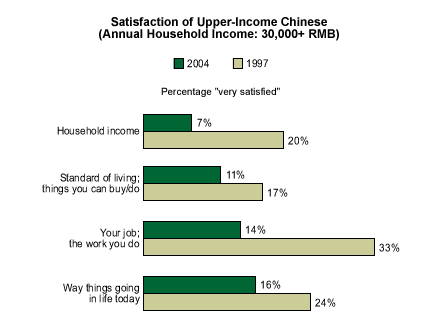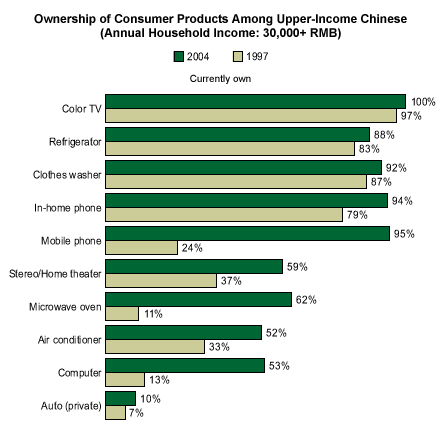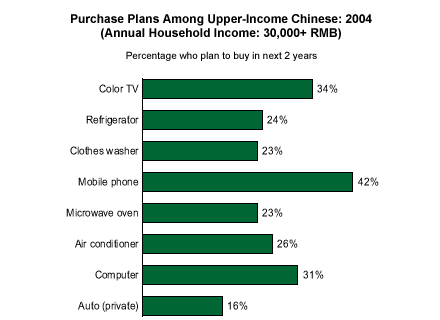China's average household income has increased impressively over the past decade. Consequently, an important segment of relatively well-to-do Chinese has emerged most obviously (but not entirely) in the urban areas. These affluent households, all with minimum annual incomes of 30,000 RMB, represent 12% of China's households -- a percentage that has doubled in only five years.
Despite their comparatively high incomes, affluent Chinese are not necessarily satisfied with either their lives or their current earnings. In 1997, 24% of those making 30,000 RMB or more annually indicated they were "very satisfied" with the way things were going in their lives. In 2004, that percentage had dropped to only 16%. As incomes have increased and the size of the upper-income group has grown, their satisfaction has dropped.
It appears increased affluence has simply gone hand in hand with greater expectations and requirements. While the "new affluents" may have more now, they are clearly not more content. This trend among affluent Chinese is consistent with the satisfaction numbers for the country as whole, which also show satisfaction decreasing as income increases (see "Chinese Far Wealthier Than a Decade Ago -- but Are They Happier?" in Related Items).

Their satisfaction hasn't grown, but the well-to-do Chinese have managed to acquire the consumer goods that represent "the good life." The typical affluent household already has what the rest of China wants: phones, refrigerators, washing machines, and color televisions. They're also well on their way to having what others may simply dream about: microwaves, stereos, computers, and air conditioners. In addition, the rapid growth in ownership of some of these household products (such as mobile phones and microwaves) bears testimony to affluents' ability to acquire what they truly want. Only in the case of private autos is ownership still rare, no doubt because the price tags can exceed the annual incomes of all but the super-affluent.

While Chinese affluents have already acquired quite a bit, they're still planning to buy more. Many are adding to or upgrading what they already own. Even though ownership of a color television is already universal among the relatively well-to-do, about one in three (34%) in this group plan to buy another color set in the next few years. An even larger percentage (42%) plans to buy a mobile phone. These figures may reflect a desire among affluents to stay "current," as well as a belief that attractive product enhancements (such as picture phones instead of "plain vanilla" handhelds) will soon become available.
Thus, there's little evidence of product saturation, and the upscale Chinese household remains a crucially important target audience for marketers of all sorts of manufactured goods. They have the means, and they have the desire.

Bottom Line
Purchasing patterns over the past few years indicate Chinese affluents have been on a buying spree, and while this buying spree hasn't produced the enhanced satisfaction with standard-of-living that might be expected, it nevertheless shows no sign of abating. Chinese consumers who have the means aren't finished buying. In Chinese households, the next decade may well be marked by a lot of "keeping up with the Zhangs."

